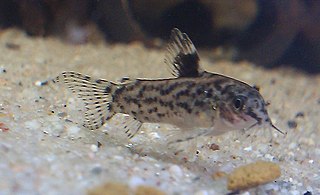| Corydoras osteocarus | |
|---|---|
| Scientific classification | |
| Kingdom: | Animalia |
| Phylum: | Chordata |
| Class: | Actinopterygii |
| Order: | Siluriformes |
| Family: | Callichthyidae |
| Genus: | Corydoras |
| Species: | C. osteocarus'' |
| Binomial name | |
| Corydoras osteocarus'' J. E. Böhlke, 1951 | |
Corydoras osteocarus is a tropical freshwater fish belonging to the Corydoradinae sub-family of the family Callichthyidae. It originates in South America, and is found in the Orinoco River basin in Venezuela and coastal rivers in Suriname. In the system of "C-Numbers" developed by the German fishkeeping magazine DATZ to identify undescribed species of Corydoras in the aquarium hobby, this fish had been assigned number "C60" until it was correctly identified.

Fish are gill-bearing aquatic craniate animals that lack limbs with digits. They form a sister group to the tunicates, together forming the olfactores. Included in this definition are the living hagfish, lampreys, and cartilaginous and bony fish as well as various extinct related groups. Tetrapods emerged within lobe-finned fishes, so cladistically they are fish as well. However, traditionally fish are rendered paraphyletic by excluding the tetrapods. Because in this manner the term "fish" is defined negatively as a paraphyletic group, it is not considered a formal taxonomic grouping in systematic biology, unless it is used in the cladistic sense, including tetrapods. The traditional term pisces is considered a typological, but not a phylogenetic classification.

Callichthyidae is a family of catfishes, called armored catfishes due to the two rows of bony plates along the lengths of their bodies. It contains some of the most popular freshwater aquarium fish, such as many species in the genus Corydoras.

South America is a continent in the Western Hemisphere, mostly in the Southern Hemisphere, with a relatively small portion in the Northern Hemisphere. It may also be considered a subcontinent of the Americas, which is how it is viewed in the Spanish and Portuguese-speaking regions of the Americas. The reference to South America instead of other regions has increased in the last decades due to changing geopolitical dynamics.
The fish will grow in length up to 1.6 inches (4.0 centimeters). It lives in a tropical climate in water with a 6.0 – 8.0 pH, a water hardness of 2 – 25 dGH, and a temperature range of 70 – 77 °F (21 – 25 °C). It feeds on worms, benthic crustaceans, insects, and plant matter. It lays eggs in dense vegetation and adults do not guard the eggs. In captivity, it produces up to 300 eggs, which it usually attaches to plants. Hatching occurs in about 3–4 days at 21.4 °C (70 °F).

In chemistry, pH is a scale used to specify how acidic or basic a water-based solution is. Acidic solutions have a lower pH, basic solutions have a higher pH. At room temperature, pure water is neither acidic nor basic and has a pH of 7.
Degrees of general hardness (dGH or °GH) is a unit of water hardness, specifically of general hardness. General hardness is a measure of the concentration of divalent metal ions such as calcium (Ca2+) and magnesium (Mg2+) per volume of water. Specifically, 1 dGH is defined as 10 milligrams (mg) of calcium oxide (CaO) per litre of water. Since CaO has a molar mass of 56.08 g/mol, 1 dGH is equivalent to 0.17832 mmol per litre of elemental calcium and/or magnesium ions.

Worms are many different distantly related animals that typically have a long cylindrical tube-like body and no limbs. Worms vary in size from microscopic to over 1 metre (3.3 ft) in length for marine polychaete worms, 6.7 metres (22 ft) for the African giant earthworm, Microchaetus rappi, and 58 metres (190 ft) for the marine nemertean worm, Lineus longissimus. Various types of worm occupy a small variety of parasitic niches, living inside the bodies of other animals. Free-living worm species do not live on land, but instead, live in marine or freshwater environments, or underground by burrowing. In biology, "worm" refers to an obsolete taxon, vermes, used by Carolus Linnaeus and Jean-Baptiste Lamarck for all non-arthropod invertebrate animals, now seen to be paraphyletic. The name stems from the Old English word wyrm. Most animals called "worms" are invertebrates, but the term is also used for the amphibian caecilians and the slowworm Anguis, a legless burrowing lizard. Invertebrate animals commonly called "worms" include annelids, nematodes (roundworms), platyhelminthes (flatworms), marine nemertean worms, marine Chaetognatha, priapulid worms, and insect larvae such as grubs and maggots.





